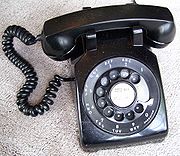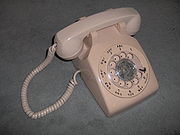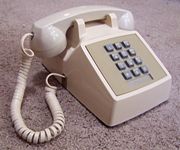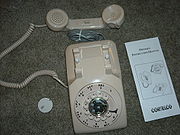
Model 500 telephone
Encyclopedia



Western Electric
Western Electric Company was an American electrical engineering company, the manufacturing arm of AT&T from 1881 to 1995. It was the scene of a number of technological innovations and also some seminal developments in industrial management...
model 500 telephone series was the standard desk-style domestic telephone
Telephone
The telephone , colloquially referred to as a phone, is a telecommunications device that transmits and receives sounds, usually the human voice. Telephones are a point-to-point communication system whose most basic function is to allow two people separated by large distances to talk to each other...
set issued by the Bell System
Bell System
The Bell System was the American Bell Telephone Company and then, subsequently, AT&T led system which provided telephone services to much of the United States and Canada from 1877 to 1984, at various times as a monopoly. In 1984, the company was broken up into separate companies, by a U.S...
in North America from late 1949 through the 1984 Bell System divestiture
Bell System divestiture
The Bell System divestiture, or the breakup of AT&T, was initiated by the filing in 1974 by the U.S. Department of Justice of an antitrust lawsuit against AT&T. The case, United States v...
. Millions of model 500-series phones were produced and were present in almost every home in North America. Many are still in use today thanks to their durability and ample availability. Its modular construction made manufacture and repair simple, and facilitated a large number of variants and derivatives with added features. Touch-Tone was introduced to home customers in 1963 with the model 1500 telephone, which had only the 10 number keys. In 1968 the model 2500 telephone was introduced, which added the * and # keys. The model 2500 is still in production today by several manufacturers, over 40 years after it was introduced.
Model 500
The original Western Electric Model 500 was designed by the firm of industrial designIndustrial design
Industrial design is the use of a combination of applied art and applied science to improve the aesthetics, ergonomics, and usability of a product, but it may also be used to improve the product's marketability and production...
er Henry Dreyfuss
Henry Dreyfuss
Henry Dreyfuss was an American industrial designer.-Career:Dreyfuss was a native of Brooklyn, New York. As one of the celebrity industrial designers of the 1930s and 1940s, Dreyfuss dramatically improved the look, feel, and usability of dozens of consumer products...
, the product of several years of research and testing, and introduced in 1949. The 500 replaced the Dreyfuss-influenced Western Electric Model 302
Model 302 telephone
The Model 302 telephone subscriber set was manufactured by Western Electric from 1937; manufacture of entirely new units was ceased after the introduction of the Model 500, but Model 302 units were continually remanufactured as such at least until 1958, and as the Model 5302 telephone which was...
, introduced in 1937, and improved upon several areas of design that were problematic in the earlier models. For example, the Model 302 utilized a porcelain-coated dial plate, with the numbers printed inside the finger holes. After years of use, the printed numbers and the even the dial plate's porcelain coating would wear off. The design of the 500 corrected this by molding them into the plastic instead of printing them on the surface. The numbers were moved outside of the dial to enable the user to see the numbers while the dial was spinning back to its resting position, to position his finger to dial the next digit. This arrangement also had the benefit of reducing mis-dialed calls.
Originally, the 500 was available only in black and had a rotary dial with a black-painted metal finger-wheel. Black remained the most popular color throughout the model's production. Within a few years the Model 500 was available in a variety of colors, and the metal finger wheel was replaced with a clear plastic rotary dial, by about 1964. The 500 was also the first phone to use the G type handset, which remains the standard handset on many phones, including public payphone
Payphone
A payphone or pay phone is a public telephone, often located in a phone booth or a privacy hood, with pre-payment by inserting money , a credit or debit card, or a telephone card....
s.
The Dreyfus design adapted itself well to Touch-Tone service. The earliest experimental Touch-Tone phones used the original Dreyfus design almost unchanged; their keypad
Keypad
A keypad is a set of buttons arranged in a block or "pad" which usually bear digits, symbols and usually a complete set of alphabetical letters. If it mostly contains numbers then it can also be called a numeric keypad...
s, in varying layouts, were placed in a roundel in the opening where the dial would normally be, with the phone number in a small window below. The 1500 and 2500 models adopted a more angular style; the curves of the original design gave way to a raised border forming a lip around the finely-ribbed faceplate, in the middle of which the keypad and number window were centered.
Model 1500
The Western Electric model 1500 telephone revised the 500 design to use Touch-ToneDual-tone multi-frequency
Dual-tone multi-frequency signaling is used for telecommunication signaling over analog telephone lines in the voice-frequency band between telephone handsets and other communications devices and the switching center. The version of DTMF that is used in push-button telephones for tone dialing is...
dialing, with buttons for only the digits 0-9. Handset cords and line cords were hardwired. It was produced from 1963 to 1968.
In addition to the basic single-line model 1500D, the Western Electric 1500-series included many related variations and special purpose models with additional features. This included sets with a headset jack, 2-line sets, keysets (1560 series), Call Directors, panel phones (1750 series), industrial phones (1520), and automatic dialers (1660).
Model 2500
The model 2500 telephone entered production in 1968. It added the # key and the * key to the keypadTelephone keypad
A telephone keypad is a keypad that appears on a "Touch Tone" telephone. It was standardised when the dual-tone multi-frequency system in the new push-button telephone was introduced in the 1960s, which gradually replaced the rotary dial....
. These keys were initially unused by ordinary customers, but would later be used for vertical service codes, and voice mail menu navigation. The 2500 is the member of the 500 family that is most commonly encountered today, as it is still produced by several companies. Handset cords and line cords were hardwired until 1974, when modular connectors were introduced.
In addition to the basic single-line model 2500D, the Western Electric 2500-series included many related variations and special purpose models with additional features. This included sets with a headset jack, 2-line sets, keysets (2560 series), Call Directors, panel phones (2750 series), industrial phones (2520), automatic dialers (2660), and sets with modular cords (2500DM).
Technical Design
The phone consisted of a rotary dial, a handset cradle, switchhook, and a handset (sometimes called the receiver) wired to the base, and was constructed of a molded thermoplastic upper housing covering a steel chassis. The user interface was extremely simple with only the dial and switch hook buttons to operate. There were no other components, switches, or controls (except for a ringer loudness control dial on the bottom). The handset cradle was a molded part of the upper housing, formed of 2 U-shaped "chairs" that held the handle part of the handset. Each chair had a round plastic button that sat atop a pair of levers connected in a spring-loaded yoke that operated the switchhook, pressing the buttons down ended the call and placed the phone "on hook". The plastic face of the dial under and surrounding the finger plate was part of the rotary dial mechanism which was exposed through a large circular hole in the phone's housing. On the bottom, the flat steel plate of the chassis was exposed. The handset cord protruded from the left side of the housing at the base, near the rear, and the line cord emerged from the rear at the base.

The most complex internal part was the rotary dial mechanism, an assembly of gears, cams, springs, and electrical contacts which electromechanically generated a timed train of line loop-break pulses when the dial finger plate was rotated and released. Standard Touch-Tone phones are able to generate 7 tones in a grid of 3 by 4, while some special purpose phones added a fourth column of keys A,B,C and D, which were generally reserved for military use (in the AUTOVON
Autovon
AUTOVON, short for Automatic Voice Network, was an American military phone system built in 1963 to survive nuclear attacks. AUTOVON was first established in the United States, using the Army's SCAN system. Around the mid-1970s AUTOVON expanded to the United Kingdom, Asia, the Middle East, and Panama...
system). Pressing a key generates the appropriate pair of DTMF tones for that key. Original sets used a transistor oscillator; newer phones make use of an integrated circuit.
The ringer was a mechanical bell consisting of two bell gongs of slightly different sizes (for different pitches) and a striker between them driven by a solenoid
Solenoid
A solenoid is a coil wound into a tightly packed helix. In physics, the term solenoid refers to a long, thin loop of wire, often wrapped around a metallic core, which produces a magnetic field when an electric current is passed through it. Solenoids are important because they can create...
; when the solenoid was energized by AC
AC power
Power in an electric circuit is the rate of flow of energy past a given point of the circuit. In alternating current circuits, energy storage elements such as inductance and capacitance may result in periodic reversals of the direction of energy flow...
ringing current (about 90 V
Volt
The volt is the SI derived unit for electric potential, electric potential difference, and electromotive force. The volt is named in honor of the Italian physicist Alessandro Volta , who invented the voltaic pile, possibly the first chemical battery.- Definition :A single volt is defined as the...
at 20 Hz
Hertz
The hertz is the SI unit of frequency defined as the number of cycles per second of a periodic phenomenon. One of its most common uses is the description of the sine wave, particularly those used in radio and audio applications....
), it struck the two gongs alternately, producing a distinctive sound composed of the rings of the two gongs combined in rapid alternation. On phones with a ringer loudness control, one gong was mounted off-center on the loudness control wheel; turning the wheel moved the gong toward (for quieter) or away from (for louder) the striker. Even so, the model 500 ringer was fairly loud and could be heard a few rooms away. The ringer was not able to be turned off by default, but this feature could be enabled by adjustment of a part of the ringer. Also, because of the mechanical design of the ringer, the striker would hit the brass bells if the phone was subjected to a sufficiently sharp mechanical shock, such as being banged down on a table, kicked, or dropped, and a short ring would be heard. This effect was faithfully represented in various films and TV shows.
Because phones in the Bell System were owned by the telephone company, which was responsible for keeping them in good repair, the Model 500 was designed to avoid repairs. As a result, it was extremely rugged and reliable, and intended to last for decades with practically no maintenance. The 1940s-era technology of the 500 made extensive use of solid metal components and point-to-point wiring, and most components were modular and simple to remove and replace. The wiring system heavily employed point to point wires terminated with crimped U-lugs and slotted screw terminals; most electrical connections in the phone could be disconnected or reconnected in seconds with just a slotted screwdriver.
Originally the line cord and handset cord were secured by screw down terminals at both ends, with a strain relief anchor. Tubular rubber covers at the ends resisted tangling and wear. The line cord (the cord that connected a desk phone to the wall) was originally the same color as the phone. In approximately 1973, the line cords were changed to a neutral gray color and from round to flat. In the late 1960s a need arose for a plug and jack system. At first a proprietary four prong plug was used only for the wall end of the line cord. A few years later much smaller "modular" plugs were introduced at both ends of both cords. These were less rugged and more convenient. A new standard RJ-11 jack was molded with lips to grip firmly the edges of the hole in the Model 500 housing.
Development
Telephones derived from the basic Model 500, using some of the same components, included the Model 554 wall-mounted phone and the 1500 and 2500 Touch-Tone phones. In the mid-1950s, to avoid disposing of older phones, Western ElectricWestern Electric
Western Electric Company was an American electrical engineering company, the manufacturing arm of AT&T from 1881 to 1995. It was the scene of a number of technological innovations and also some seminal developments in industrial management...
manufactured a 500-style plastic replacement shell to update the appearance of the 302, calling it the Model 5302
Model 5302 telephone
The Model 5302 telephone was created in 1954 by Western Electric to provide customers a "modern looking" telephone while permitting the Bell System to recycle and reuse components from the older 300 series to use up existing supplies of 302 parts, as well as to meet increased post-World War II...
. This model used the internal components of Western Electric's earlier Model 302
Model 302 telephone
The Model 302 telephone subscriber set was manufactured by Western Electric from 1937; manufacture of entirely new units was ceased after the introduction of the Model 500, but Model 302 units were continually remanufactured as such at least until 1958, and as the Model 5302 telephone which was...
phone, and was issued with both the F and G style handsets.
In addition to the model 500, the Western Electric 500-series included many related variations and special purpose models with additional features. This included phones with dial lights (500U), party line sets (501), keysets (540 and 560 series), Call Directors, panel phones (750 series), industrial and outdoor phones (520 and 525), and automatic dialers (660).
As with all telephones of the time in the US, the 500 phones were owned by the local Bell Operating Company, most of which were owned by AT&T, which also owned Western Electric itself—and leased on a monthly basis by customers. This monopoly made millions of dollars for AT&T, with the secondary effect of limiting phone choices and styles. AT&T strictly enforced policies against buying and using phones by other manufacturers, purportedly to ensure the technical integrity of their network. Most phones made by Western Electric, starting in about 1968, carried this disclaimer permanently molded into their housings: "BELL SYSTEM PROPERTY--NOT FOR SALE." Telephones were also sometimes labeled with a sticker marking the Bell Operating Company that owned the telephone. After some consumers began buying phones from other manufacturers (in the wake of legal developments not favoring AT&T's ban against third-party equipment) AT&T changed its policy for its Design Line telephone
Design Line telephone
Design Line is a brand that AT&T has used on several of its telephones, also known as Deco-Tel.-Pre-divestiture Design Line:In the early 1970s, before the Bell System divestiture, customers in increasing numbers chose to install and use telephones not manufactured by Western Electric, AT&T's wholly...
series by selling customers the phone's housing but retaining ownership of the mechanical components, so customers were still required to pay AT&T a monthly leasing fee.
In 1983, after the court ordered divestiture
Bell System divestiture
The Bell System divestiture, or the breakup of AT&T, was initiated by the filing in 1974 by the U.S. Department of Justice of an antitrust lawsuit against AT&T. The case, United States v...
, AT&T started selling phones outright to the public through its then-new American Bell division. Many customers were offered the option to buy their currently leased telephones in place, and many accepted the offer. AT&T closed its USA consumer telephone manufacturing plants in 1986, and moved production to Singapore, China, Thailand, and in the 1990s, Mexico; this let them produce lower quality phones at lower prices.
Other Model 500 manufacturers

Nortel
Nortel Networks Corporation, formerly known as Northern Telecom Limited and sometimes known simply as Nortel, was a multinational telecommunications equipment manufacturer headquartered in Mississauga, Ontario, Canada...
(which eventually became Northern Telecom). Cortelco continues to produce a non dial version of the model 500, known as the Model 89001047PAK, this phone is only available in bright red. Stromberg-Carlson
Stromberg-Carlson
Stromberg-Carlson was a telecommunications equipment and electronics manufacturing company formed in 1894 as a partnership of Alfred Stromberg and Androv Carlson. Along with four other companies, it controlled the United States national supply of telephone equipment until after World War...
(now part of Siemens
Siemens AG
Siemens AG is a German multinational conglomerate company headquartered in Munich, Germany. It is the largest Europe-based electronics and electrical engineering company....
) also made the phones from the 1950s-1980s.
Replicas
Some contemporary replicas of the 500 model are available. While faithful from a cosmetic point of view they are internally very different from the original, including a rotating tone dialer based on optical technology.In popular culture
The Model 500 series, and its distinctive ring, are near-ubiquitous in late 20th-century U.S. and Canadian film and television.- Perhaps attesting to their robust construction, Model 500s are shown as an effective weapon in the film True LiesTrue LiesTrue Lies is a 1994 American action-comedy film directed by James Cameron and starring Arnold Schwarzenegger, Jamie Lee Curtis, Tom Arnold, Bill Paxton, Tia Carrere, Charlton Heston, and Art Malik. Eliza Dushku also appears in the film in one of her first major film roles...
.
External links
- Western Electric Telephone Models
- Western Electric 500-series Models
- http://www.cortelco.com/pdf/2008SolGuide.pdf
- Western Electric 1500-series Models
- Western Electric 2500-series Models
- Western Electric Model 500
- Western Electric Model 554
- Western Electric Model 1500 and 2500 Telephone
- Western Electric Model 1554 and 2554 Telephone

